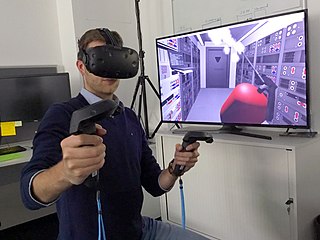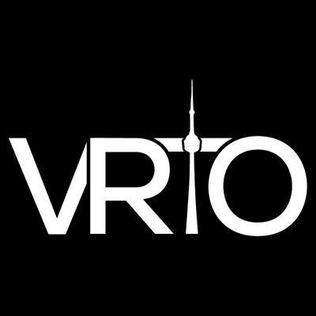
Virtual reality (VR) is a simulated experience that can be similar to or completely different from the real world. Applications of virtual reality include entertainment, education and business. Other distinct types of VR-style technology include augmented reality and mixed reality, sometimes referred to as extended reality or XR.

Mixed reality (MR) is the merging of real and virtual worlds to produce new environments and visualizations, where physical and digital objects co-exist and interact in real time. Mixed reality does not exclusively take place in either the physical world or virtual world, but is a hybrid of reality and virtual reality. Augmented reality, a related term, takes place in the physical world, with information or objects added virtually.
The Metaverse is a collective virtual shared space, created by the convergence of virtually enhanced physical reality and physically persistent virtual space, including the sum of all virtual worlds, augmented reality, and the Internet. The word "metaverse" is made up of the prefix "meta" and the stem "verse" ; the term is typically used to describe the concept of a future iteration of the internet, made up of persistent, shared, 3D virtual spaces linked into a perceived virtual universe.
The Virtual Reality Applications Center (VRAC) is a research center within the Engineering Teaching and Research Complex (ETRC) at Iowa State University (ISU) and is involved in advanced research of virtual reality (VR), augmented reality (AR), human computer interaction (HCI), visualization, and is home to the world's highest resolution immersive virtual reality facility, known as the C6.
Keram Malicki-Sánchez is an actor, singer, composer, writer, essayist, interactive media developer music producer, film producer and film director.

Immersion into virtual reality (VR) is a perception of being physically present in a non-physical world. The perception is created by surrounding the user of the VR system in images, sound or other stimuli that provide an engrossing total environment.
A projection augmented model is an element sometimes employed in virtual reality systems. It consists of a physical three-dimensional model onto which a computer image is projected to create a realistic looking object. Importantly, the physical model is the same geometric shape as the object that the PA model depicts.

castAR was a Palo Alto-based technology startup company founded in March 2013 by Jeri Ellsworth and Rick Johnson. Its first product was to be the castAR, a pair of augmented reality and virtual reality glasses. castAR was a founding member of the nonprofit Immersive Technology Alliance.

Windows Mixed Reality is a mixed reality platform introduced as part of the Windows 10 operating system, which provides augmented reality and mixed reality experiences with compatible head-mounted displays.

Extended reality (XR) is a term referring to all real-and-virtual combined environments and human-machine interactions generated by computer technology and wearables, where the 'X' represents a variable for any current or future spatial computing technologies. E.g. It includes representative forms such as augmented reality (AR), mixed reality (MR) and virtual reality (VR) and the areas interpolated among them. The levels of virtuality range from partially sensory inputs to immersive virtuality, also called VR.

Open Source Virtual Reality (OSVR) is an open-source software project that aims to enable headsets and game controllers from all vendors to be used with any games developed by Razer and Sensics. It is also a virtual reality headset that claims to be open-source hardware using the OSVR software.
WebVR was an experimental JavaScript application programming interface (API) that enabled applications to interact with virtual reality devices, such as the HTC Vive, Oculus Rift, Google Cardboard or Open Source Virtual Reality (OSVR) in a web browser. It was implemented in Firefox and Chromium-based browsers before being deprecated and removed. The WebVR API was superseded by a more powerful WebXR API that is capable of representing virtual reality and augmented reality devices simultaneously.
OpenVR is a software development kit (SDK) and application programming interface developed by Valve for supporting the SteamVR and other virtual reality headset (VR) devices. The SteamVR platform uses it as the default application programming interface (API) and runtime. It serves as the interface between the VR hardware and software and is implemented by SteamVR.

A virtual reality headset is a head-mounted device that provides virtual reality for the wearer. Virtual reality (VR) headsets are widely used with video games but they are also used in other applications, including simulators and trainers. They comprise a stereoscopic head-mounted display, stereo sound, and head motion tracking sensors.

Started in 2015, as a Virtual Reality Meetup Group in Toronto, VRTO launched the VRTO Virtual & Augmented Reality World Conference & Expo in June 2016 - an international exhibition and professional conference exploring arts, culture and science through immersive technologies. Its inaugural year - held at the Mattamy Centre - featured keynotes from University of Toronto Professor Steve Mann, Hollywood film director Brett Leonard - director of The Lawnmower Man, Chief Digital Officer Ana Serrano of the Canadian Film Centre and Phil Lelyveld of USC.
OpenXR is an open, royalty-free standard for access to virtual reality and augmented reality platforms and devices. It is developed by a working group managed by the Khronos Group consortium. OpenXR was announced by the Khronos Group on February 27, 2017 during GDC 2017. A provisional version of the standard was released on March 18, 2019 to enable developers and implementers to provide feedback on it. On July 29, 2019, OpenXR 1.0 was released to the public by Khronos Group at SIGGRAPH 2019.
Virtual reality (VR) is a computer application which allows users to experience immersive, three dimensional visual and audio simulations. According to Pinho (2004), virtual reality is characterized by immersion in the 3D world, interaction with virtual objects, and involvement in exploring the virtual environment. The feasibility of the virtual reality in education has been debated due to several obstacles such as affordability of VR software and hardware. The psychological effects of virtual reality are also a negative consideration. However, recent technological progress has made VR more viable and promise new learning models and styles for students. These facets of virtual reality have found applications within the primary education sphere in enhancing student learning, increasing engagement, and creating new opportunities for addressing learning preferences.

Virtual reality applications are applications that make use of virtual reality (VR), an immersive sensory experience that digitally simulates a virtual environment. Applications have been developed in a variety of domains, such as education, architectural and urban design, digital marketing and activism, engineering and robotics, entertainment, virtual communities, fine arts, healthcare and clinical therapies, heritage and archaeology, occupational safety, social science and psychology.
Kent Bye is an American podcaster and experiential journalist based in Portland, OR. He is most known for his work in virtual reality, augmented reality, and artificial intelligence.









